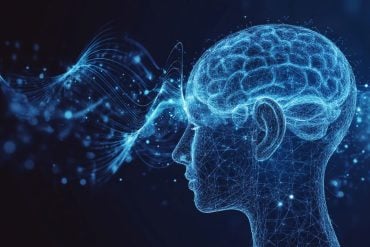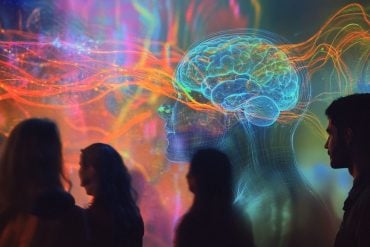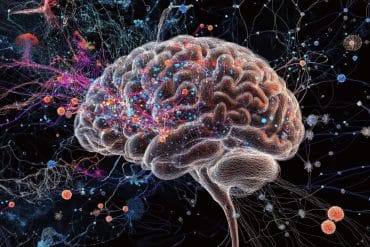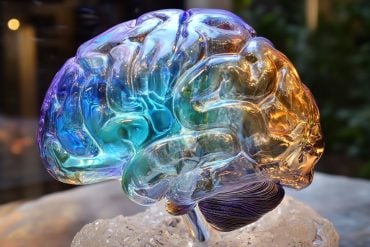Summary: In people with PTSD, during REM sleep norepinephrine and serotonin levels remain high, reducing the brain’s ability to inhibit fear-expression neurons through neural rhythms sent between the prefrontal cortex and amygdala. Those with PTSD require higher frequency rhythms to extinguish fear memories. Researchers say unlocking the higher frequencies via therapies could help to restore quality sleep in those with PTSD.
Source: Virginia Tech
During periods of rapid eye movement (REM) sleep, brain activity often resembles that of awake behavior. At times, the brain can actually be more active during REM sleep than when you’re awake. It’s why REM sleep is sometimes called “paradoxical sleep,” said Virginia Tech neuroscientist Sujith Vijayan.
And for those who experience post-traumatic stress disorder, this very active sleep stage tends to be fraught with emotionally charged dreams, “over and over,” Vijayan said.
The sleeping brain can typically bring up emotional memories, process them, and remove their emotional charge, Vijayan said. It’s a process that may be explained by an evolutionary drive to evaluate important memories, including those tied to fear.
But in post-traumatic sleep disorder (PTSD) patients, the brain seems to bring bad dreams back night after night, driven to evaluate fear memories but unable to ever remove their emotional charge. So what keeps the brain stuck in that loop?
For a new study published by the Journal of Neuroscience, Vijayan led a team in creating biophysically based models of the sleeping brain, to explore at a deeper, mechanistic level how the brain may — or may not, with PTSD — effectively process and extinguish fear memories.
During REM sleep, levels of the neurotransmitters norepinephrine and serotonin usually go down. With their models, the researchers linked lowered neurotransmitter levels to the brain’s ability to inhibit fear expression cells, through rhythms sent between the prefrontal cortex and the amygdala. Vijayan’s team then probed how the atypical neurotransmitter levels seen in the sleeping PTSD patient’s brain could disrupt the fear-quelling work of those brain rhythms.
With PTSD, neurotransmitter levels stay high during REM sleep. The team’s models show that under these altered conditions, brain rhythms typically effective in healthy individuals can no longer inhibit fear memories. Instead, the PTSD patient’s brain seems to need higher-frequency rhythms to extinguish fear memories.
Unlocking those higher frequencies could inform therapies to return the restorative quality of sleep to people experiencing PTSD, the researchers believe.
The ‘Wild West’ of sleep stages
Vijayan, who has long studied how sleep affects learning and memory, describes REM sleep as a kind of “Wild West” in terms of what we know about its relationship with memory. The sleep stage is thought to be important for processing emotional memories, and experiments have shown that rhythmic interactions between the amygdala and the prefrontal cortex during REM sleep reduce the expression of fear-associated memories. But it’s unclear just how this works.
With most of the work in neuroscience dedicated to non-REM sleep, “REM sleep is a lot harder to get your hands around,” said Vijayan, an assistant professor in the School of Neuroscience, part of the Virginia Tech College of Science.
“There are really good models out there for how non-REM sleep might consolidate memories and what role it might play in learning and memory. But when we talk about REM, there are no real, good models on how that stuff is happening.”
Vijayan sought to change that by creating biophysically based models of REM sleep, enabling his team to learn more about what allows brain rhythms to help with emotional memory processing — and how PTSD disrupts it. The models allowed the scientists to manipulate the REM sleep conditions that they believed could be key to this question: neurotransmitter levels.
Starting with models of sleep conditions in what could be considered a healthy individual’s brain, Vijayan’s team brought norepinephrine and serotonin levels down to represent REM sleep.
As a result, rhythmic interactions between neurons in the prefrontal cortex and neurons in the amygdala strengthened connections between those two areas. Brain rhythms coming from the prefrontal cortex effectively inhibited the activity of fear memory cells in the amygdala.
The team also found that a specific frequency of brain rhythms was particularly effective at inhibiting fear expression cells. When inputting frequencies in the theta range of rhythms typical for humans — four to eight hertz — they found that lower-frequency theta rhythms of around four hertz most effectively strengthened connections between frontal areas and the amygdala.

The researchers then modeled REM sleep in people experiencing PTSD. It’s known that PTSD causes norepinephrine levels to remain high during REM sleep. Vijayan’s team mimicked those conditions and found that when they introduced brain rhythms at four to eight hertz, those rhythms could no longer suppress fear expression cells.
“I’m a little surprised that the four hertz didn’t work,” Vijayan said. “I thought maybe it would still be effective, but it really wasn’t at all.”
Restoring the recuperative power of sleep
There’s still hope for breaking the cycle of fear-filled dreams, the team found. Though the typical four- to eight-hertz frequency of brain rhythms couldn’t do the work of inhibiting fear expression cells, the researchers tried other frequencies. They found that at a higher frequency of 10 hertz, brain rhythms could effectively inhibit those cells in their PTSD model of the sleeping brain.
By pinpointing the atypical frequencies of brain rhythms that can inhibit fear memories in PTSD patients, Vijayan believes his team can tap into therapies. Their next step is to look at ways to trigger adjustments to the sleeping PTSD patient’s brain rhythm frequencies to reach the right rhythms for them. It’s possible to do so using what Vijayan calls covert auditory stimulation.
“That means I’m playing those sounds and you’re not aware of it while you’re sleeping,” Vijayan said. “That could be useful for any sort of disorder where sleep is disrupted, not only in PTSD, but in traumatic brain injury or Parkinson’s disease. The idea is that by inducing desired neural dynamics, we can engage the recuperative powers of sleep.”
About this PTSD and sleep research news
Author: Margaret Ashburn
Source: Virginia Tech
Contact: Margaret Ashburn – Virginia Tech
Image: The image is in the public domain
Original Research: Closed access.
“Emotional Memory Processing during REM Sleep with Implications for Post-Traumatic Stress Disorder” by Sujith Vijayan et al. Journal of Neuroscience
Abstract
Emotional Memory Processing during REM Sleep with Implications for Post-Traumatic Stress Disorder
REM sleep is important for the processing of emotional memories, including fear memories. Rhythmic interactions, especially in the theta band, between the medial prefrontal cortex (mPFC) and limbic structures are thought to play an important role, but the ways in which memory processing occurs at a mechanistic and circuits level are largely unknown.
To investigate how rhythmic interactions lead to fear extinction during REM sleep, we used a biophysically based model that included the infralimbic cortex (IL), a part of the mPFC with a critical role in suppressing fear memories.
Theta frequency (4–12 Hz) inputs to a given cell assembly in IL, representing an emotional memory, resulted in the strengthening of connections from the IL to the amygdala and the weakening of connections from the amygdala to the IL, resulting in the suppression of the activity of fear expression cells for the associated memory.
Lower frequency (4 Hz) theta inputs effected these changes over a wider range of input strengths. In contrast, inputs at other frequencies were ineffective at causing these synaptic changes and did not suppress fear memories.
Under post-traumatic stress disorder (PTSD) REM sleep conditions, rhythmic activity dissipated, and 4 Hz theta inputs to IL were ineffective, but higher-frequency (10 Hz) theta inputs to IL induced changes similar to those seen with 4 Hz inputs under normal REM sleep conditions, resulting in the suppression of fear expression cells.
These results suggest why PTSD patients may repeatedly experience the same emotionally charged dreams and suggest potential neuromodulatory therapies for the amelioration of PTSD symptoms.







